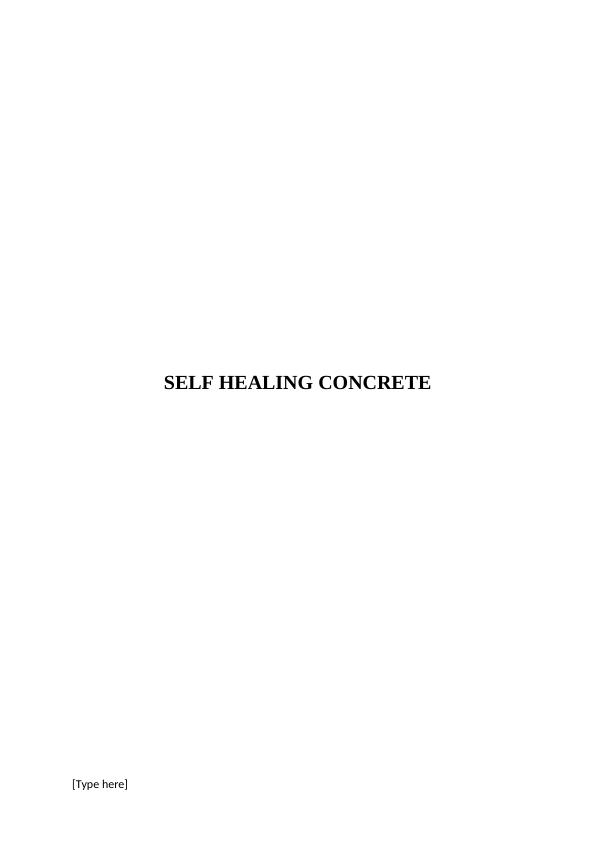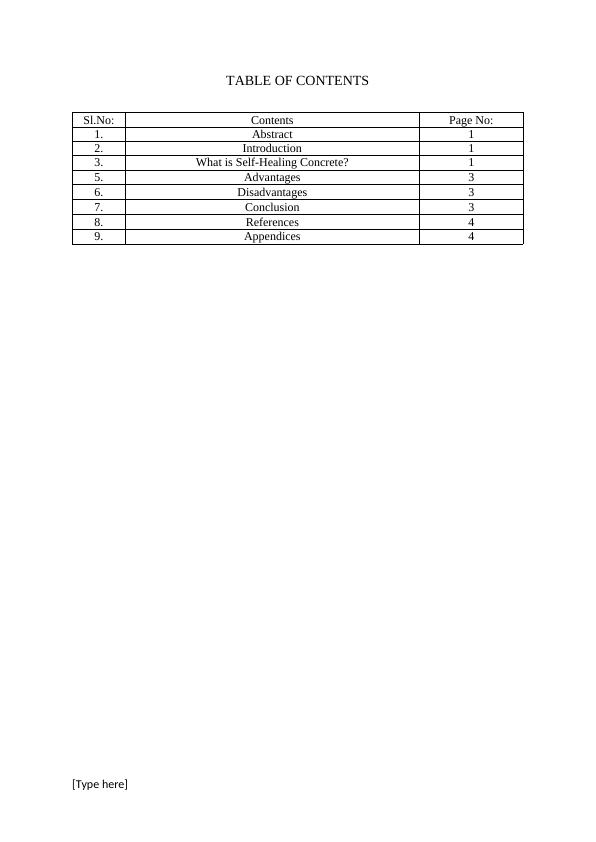Ask a question from expert
BSCE1B - Self Healing Concrete | Assignment
7 Pages1523 Words325 Views
Supervise and apply quality standards to the selection of building and construction materials (CPCCBC5004A)
Added on 2020-03-04
BSCE1B - Self Healing Concrete | Assignment
Supervise and apply quality standards to the selection of building and construction materials (CPCCBC5004A)
Added on 2020-03-04
BookmarkShareRelated Documents
SELF HEALING CONCRETE[Type here]

TABLE OF CONTENTSSl.No:ContentsPage No:1.Abstract12.Introduction13.What is Self-Healing Concrete?15.Advantages36.Disadvantages37.Conclusion38.References49.Appendices4[Type here]

1AbstractThe material selected for conducting this research is Self-Healing Concrete which israther a new technology used in construction. Self-Healing Concrete has installed dirtparticles that contain torpid microscopic organisms and a sustenance source. At the pointwhen a break shows up in the solid, water leaks in and enacts the microscopic organisms.When they wake, the microbes have their stuffed lunch and discharge chalk, which fills thebreak. This paper deals with the compatibility, cost effectiveness, advantages anddisadvantages of Self-Healing concrete.IntroductionConcrete will keep on being the most vital building material for foundation regardlessof being inclined to splitting. Minor cracks on the surface of the solid make the entirestructure powerless in light of the fact that water leaks in to corrupt the solid and erode thesteel fortification, incredibly decreasing the life expectancy of a structure. Motorway spansare additionally defenseless on the grounds that salts used to deice the streets infiltrate in tothe splits in the structures and can quicken the erosion of steel fortification. In numerousstructural building structures elastic strengths can prompt breaks and these can happengenerally not long after the structure is assembled. Repair of customary solid structures forthe most part includes applying a solid mortar which is clung to the harmed surface. Frequentrepairs can be tedious and costly in light of the fact that it is exceptionally hard to access thestructure to make repairs, particularly on the off chance that they are underground or at anincredible height. Thus there is a need for an alternative and more cost effective method ofrepairing concrete structures.What is Self-Healing Concrete?Self-healing concrete helps to patch the cracks that appear on the surface of strongstructures using limestone. The components of concrete are blended with carefully pickedsorts of the minuscule life form assortment Bacillus, calcium lactate, nitrogen and phosphorusto produce self-healing concrete1. These self-patching masters lie dormant inside the concretefor up to 200 years1. When a strong structure cracks water starts to spill through the cracks,the spores of the microorganisms start to develop on contact with water and supplements1.Then, the microorganism starts to devour the calcium lactate2. As the minuscule life formsenergizes oxygen is used to convert the dissolvable calcium lactate into insoluble limestone2.The limestone fills up the cracks on the split surface, thereby setting it up. It copies themethod by which bone splits in the human body are ordinarily recovered by osteoblast cellsthat mineralize to change the bone. The bacterial conversion of calcium lactate to limestone by consuming oxygenimproves the solidness of steel and strengthens the solid structure because the bacterial actionconsumes all the oxygen without which steel would not corrode2. The two self-recuperatingspecialists namely bacterial spores and calcium lactate-based supplements are acquaintedwith the concrete and extended clay pellets 2-4 mm wide, guarantee that the specialists won'tbe enacted during the concrete blending process2. The bacteria are enacted only when thesplits open up the pellets and allow water to bring calcium lactate and bacteria in contact2.1Jonkers H.M. and Schlangen, E. “Development of a bacteria-based self healingconcrete.” Tailor Made Concrete Structures – Walraven & Stoelhorst (eds), (2008): 426.2Schlangen, E., Jonkers, H., Qian, S. and Garcia, A. “Recent advances on self healingof concrete.” Proceedings of Fracture Mechanics of Concrete and Concrete Structures 7,(2010): 292-293.

End of preview
Want to access all the pages? Upload your documents or become a member.
Related Documents
Self-Healing Concrete (Bio Concrete)lg...
|14
|2348
|54